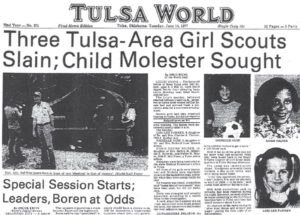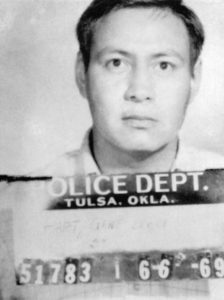The Curious Case of the Oklahoma Girl Scout Murders

It’s a story I’ve heard about in the past few years and it’s like something out of a horror film. A group of innocent young girls say goodbye to their parents at Camp Scott in Oklahoma in 1977, and three of them are murdered in the night before the adventure even begins.
A camp counselor found three sleeping bags containing the bodies of Lori Farmer (age 8), Michelle Guse (age 9) and Denise Milner (age 10) on the morning of June 14, 1977. The girls had been sexually assaulted and murdered, and then left on a trail not far from the tent they had been sleeping in during a thunderstorm the night before.
I heard about this case in more detail in a two-part episode the Unsolved Murders: True Crime podcast ran called “The Oklahoma Girl Scout Murders.” The case made my heart break on a number of levels. For one, these three girls were sleeping in a tent all by themselves on the night of the murders. During a storm, which had to have been scary. They were writing letters home, the contents which were later published. During the investigation, officials discovered a counselor had heard odd sounds in the middle of the night coming from the direction of the girls’ tent, including a guttural moaning. She got up with a flashlight and investigated the noise, but couldn’t find anything. Another scout reported hearing a scream coming from the direction of where the three girls’ were sleeping in their tent. Another counselor remembered hearing a girl cry, “Mama! Mama!” I know the 1970s was a different era, but there sure didn’t seem to be much in the way of security for a place responsible for caring for such young girls. (The families of the victims did eventually sue the organization that owned the camp, but they lost).

Camp Scott was evacuated and shut down the day after the murders. A local farmer called police and told them he had seen a man hiding out in a cave near his property, which made them suspicious. A convicted rapist, Gene Leroy Hart, had escaped from police custody in 1973 and had never been captured. Law enforcement wondered if he could have been involved in the Girl Scout murders. When they checked out the cave, the found evidence from the camp, including a roll of tape (like tape used on the girls’ hands) and a pair of sunglasses that had belonged to one of the camp counselors. They caught up to Hart in an abandoned cabin 10 months later, and he went on trial for the murders.
Many in the community rallied behind Hart, a former high school football star, including members of the Native American population who felt he was being railroaded because of his ethnicity. DNA testing was not as sophisticated as it is today, so the samples taken from the murder scene could not be definitively tied to Hart. The case was purely circumstantial, and he was eventually acquitted. He did have to return to prison for the 1973 rapes of two pregnant women. In 1979, only two months after his trial, he died in prison of a heart attack.
There are people in Oklahoma who think he got away with murder, but that karma worked its magic in the end with Hart dying so quickly in prison. Others wonder if there could have been another killer, or killers. A boot print was found at the crime scene that wasn’t linked to hart. A re-test of DNA in 2008 was inconclusive, as too much time had passed with a degraded semen sample. The current sheriff in Mayes County has raised more than $30,000 for a new round of DNA testing on evidence from the crime scene that still remains.
Hopefully, with a renewed sense of interest on the case and advances in technology, the families of these three young girls will find some closure soon.
One Comment
Pingback: